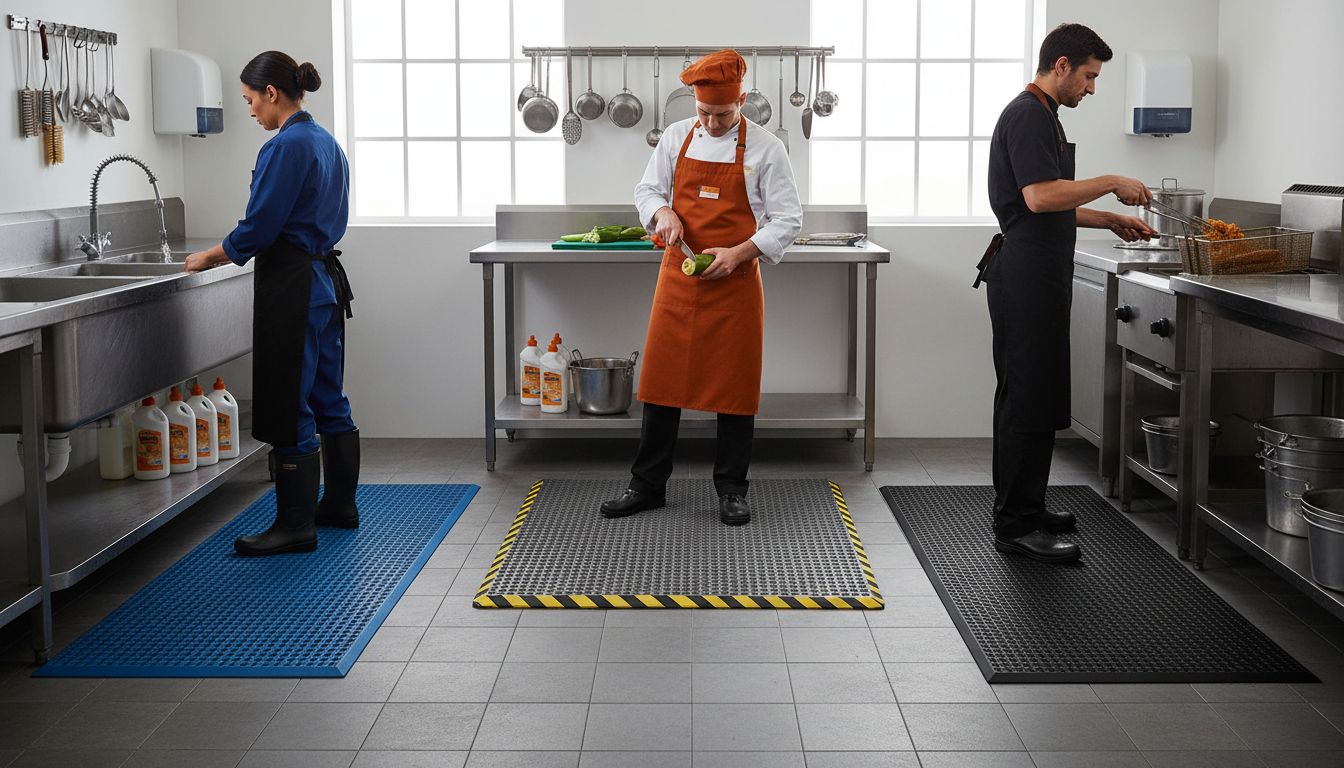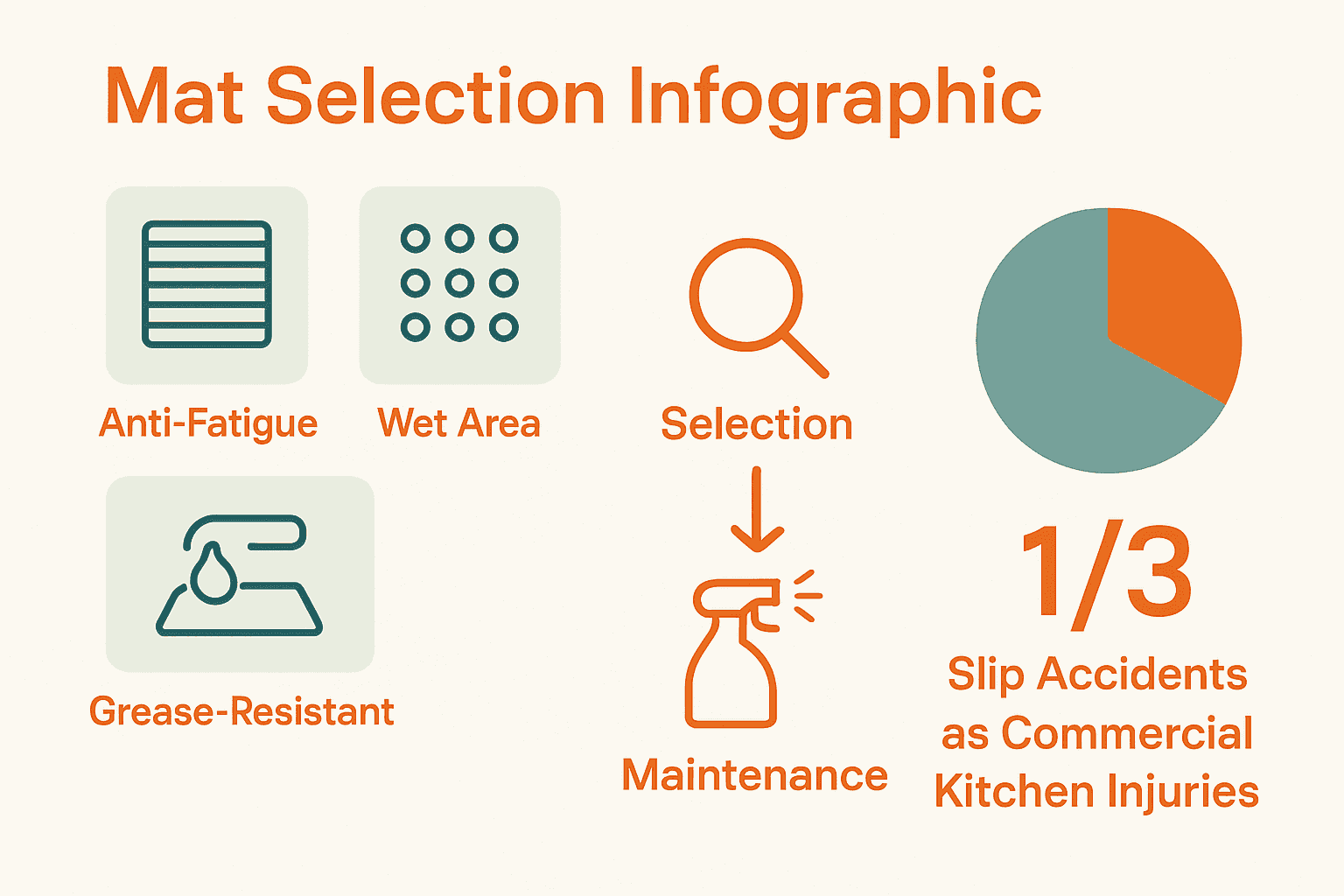Most british commercial kitchens face a surprising risk of workplace injuries, with slips and trips accounting for nearly one third of all reported accidents in the food industry. The unique demands of these environments call for more than just basic cleaning routines. Choosing the right floor mats can not only protect staff from hazards but also support hygiene, efficiency, and compliance with strict safety regulations. Understanding the true purpose and key features of commercial kitchen floor mats makes all the difference.
Table of Contents
- Defining Commercial Kitchen Floor Mats
- Main Types And Key Differences
- Essential Features And Performance Criteria
- Uk Hygiene And Safety Regulations
- Selecting, Installing, And Maintaining Mats
- Comparing Alternatives And Common Mistakes
Key Takeaways
| Point | Details |
|---|---|
| Importance of Floor Mats | Commercial kitchen floor mats are essential for enhancing safety and operational efficiency while reducing liability risks in food preparation environments. |
| Types of Mats | Various specialised mats, such as anti-fatigue, wet area, and grease-resistant, cater to unique workplace challenges for improved safety and hygiene. |
| Performance Standards | High-quality mats must meet specific performance criteria, including slip resistance, chemical durability, and ergonomic design to ensure consistent safety. |
| Regulatory Compliance | Compliance with UK hygiene and safety regulations is critical, as it encompasses strict guidelines for mat material, maintenance, and performance standards. |
Defining Commercial Kitchen Floor Mats
Commercial kitchen floor mats are specialized safety and performance solutions designed to protect workers, enhance workplace efficiency, and meet stringent hygiene standards in professional food preparation environments. According to Culture Southwest, these mats are critical workplace investments utilized across various commercial and industrial settings to improve safety and reduce potential liability risks.
These highly engineered floor coverings serve multiple crucial functions beyond simple floor protection. Commercial kitchen floor mats are specifically constructed to address unique challenges such as wet surfaces, grease exposure, high-traffic areas, and potential slip hazards. They typically feature advanced materials like rubber, vinyl, or specialized synthetic composites that provide superior grip, drainage, and resistance to kitchen-specific contaminants like oils, water, and cleaning chemicals.
In professional kitchens, where worker safety is paramount, these mats play a critical role in preventing workplace accidents. As LBBD highlights through workplace regulations, commercial kitchens are high-risk environments that demand comprehensive safety measures. The right floor mat can significantly mitigate potential injury risks by:
- Providing slip-resistant surfaces
- Reducing fatigue for standing workers
- Absorbing impact and minimizing potential floor damage
- Creating clear demarcation zones for different kitchen areas
- Supporting workplace hygiene standards
Modern commercial kitchen floor mats are not just functional accessories but strategic investments in workplace safety, efficiency, and operational excellence. They represent a proactive approach to managing workplace risks and creating environments that support worker health and productivity.
Main Types and Key Differences
Commercial kitchen floor mats come in several specialized variations, each designed to address specific workplace challenges and safety requirements. Culture Southwest highlights the diversity of workplace matting solutions, emphasizing that different environments demand targeted flooring strategies to enhance safety and operational efficiency.
Anti-Fatigue Mats represent a critical category specifically engineered for workers who spend extended periods standing. These mats feature specialized cushioning that reduces physical strain, minimizes muscle fatigue, and provides ergonomic support in high-intensity kitchen environments. Constructed from materials like dense rubber or advanced polymers, they help redistribute body weight and reduce stress on joints during long shifts.
Another essential category is Wet Area Mats, which are specifically designed for environments prone to liquid spillage and potential slip hazards. These mats typically incorporate:
- Raised drainage patterns
- Grease-resistant surfaces
- Bevelled edges to prevent tripping
- Quick-drying materials
- Enhanced slip-resistant textures
Specialized Grease-Resistant Mats offer additional protection in cooking zones, featuring chemical-resistant compounds that withstand frequent exposure to oils, cleaning chemicals, and high-temperature environments. These mats not only provide safety benefits but also contribute to maintaining stringent hygiene standards in professional kitchens.
The final prominent category includes Modular Safety Mats, which offer flexible, customizable solutions for different kitchen layouts. These mats can be interconnected to create comprehensive floor coverage, allowing businesses to design precise safety zones tailored to specific workplace configurations. By understanding these distinct mat types, commercial kitchens can implement targeted flooring solutions that significantly enhance workplace safety and operational efficiency.

Essential Features and Performance Criteria
Commercial kitchen floor mats must meet rigorous performance standards to ensure workplace safety and operational efficiency. According to Culture Southwest, effective floor matting should provide critical features such as slip resistance, durability, and ease of maintenance to protect workers and enhance workplace environments.
Performance Criteria for commercial kitchen floor mats encompass multiple critical dimensions. These include material resilience, chemical resistance, thermal stability, and ergonomic design. High-quality mats must withstand extreme temperatures, resist grease and cleaning chemical exposure, and maintain structural integrity under constant foot traffic and potential heavy equipment movement. Advanced mats incorporate multilayered constructions that balance shock absorption, slip prevention, and long-term durability.
The essential features of top-tier commercial kitchen floor mats can be categorized into key performance domains:
-
Safety Performance
- Slip resistance ratings above industry standards
- Impact absorption capabilities
- Bevelled edges to prevent tripping
- High-visibility color options
-
Material Durability
- Resistance to oils and cleaning chemicals
- UV and temperature stability
- Antimicrobial surface treatments
- Puncture and tear resistance
-
Ergonomic Considerations
- Cushioning to reduce worker fatigue
- Weight distribution support
- Flexible yet stable material composition
- Adaptable to different standing positions
Additionally, modern commercial kitchen floor mats must meet stringent hygiene and safety regulations. This includes being easy to clean, resistant to bacterial growth, and capable of withstanding frequent sanitization processes. The most advanced mats integrate smart design features like modular connectivity, quick-drainage systems, and customizable configurations that allow businesses to create tailored safety solutions for their specific workplace environments.
UK Hygiene and Safety Regulations
Commercial kitchen floor mat regulations in the United Kingdom are comprehensive and stringent, designed to protect workers and maintain exceptional workplace safety standards. LBBD highlights the critical nature of workplace safety regulations, particularly emphasizing the prohibition of children in commercial kitchen environments, which underscores the high-risk nature of these professional spaces.
Safety Compliance requires commercial kitchen floor mats to meet multiple rigorous standards. As specified by Gov UK, floor surfaces must be firm, even, easily cleaned, and slip-resistant under both wet and dry conditions. These requirements mandate that floor mats provide consistent performance, minimizing potential workplace accidents and supporting comprehensive risk management strategies.
Key regulatory considerations for commercial kitchen floor mats include:
-
Health and Safety Regulations
- Compliance with HSE workplace safety guidelines
- Minimum slip resistance ratings
- Chemical resistance standards
- Ergonomic design requirements
-
Hygiene Standards
- Antimicrobial surface specifications
- Easy sanitization capabilities
- Resistance to bacterial growth
- Non-porous material requirements
-
Workplace Protection
- Impact absorption standards
- Load-bearing capacity regulations
- Temperature resistance specifications
- Material durability guidelines
Additionally, UK regulations mandate comprehensive documentation and periodic safety assessments for workplace flooring solutions. Commercial kitchens must maintain detailed records demonstrating their floor matting systems meet current safety standards, with regular inspections and maintenance logs serving as critical evidence of regulatory compliance. These stringent requirements ensure that floor mats are not merely decorative accessories but essential safety infrastructure protecting workers and maintaining operational excellence.
Selecting, Installing, and Maintaining Mats
Culture Southwest emphasizes that selecting commercial kitchen floor mats requires careful consideration of specific environmental needs, including foot traffic patterns, potential hazards, and unique workplace characteristics. The selection process is not merely about purchasing a mat, but strategically choosing a solution that enhances workplace safety and operational efficiency.
Zoning Strategy plays a critical role in mat selection and installation. According to the same source, effective mat placement involves understanding different area requirements and implementing a targeted approach. This means deploying specialized mats in specific zones: anti-fatigue mats in high-standing areas, slip-resistant mats near wet zones, and grease-resistant mats in cooking stations. Master commercial mat cleaning techniques will help extend the lifespan and effectiveness of these strategically placed floor coverings.
Key considerations for comprehensive mat management include:
-
Selection Criteria
- Material durability
- Chemical resistance
- Specific workplace hazards
- Traffic volume
- Temperature exposure
-
Installation Best Practices
- Ensure level, clean surface
- Proper edge alignment
- Avoid potential tripping points
- Use appropriate adhesive or fixing methods
- Check for consistent contact with floor
-
Maintenance Protocols
- Regular visual inspections
- Weekly deep cleaning
- Immediate replacement of damaged sections
- Monitor mat thickness and grip
- Document maintenance activities
Professional mat management extends beyond simple placement. It requires a holistic approach that integrates safety, hygiene, and operational efficiency.
 Regular assessment, proactive maintenance, and strategic replacement ensure that commercial kitchen floor mats continue to provide optimal protection, reduce workplace accidents, and support a safe working environment.
Regular assessment, proactive maintenance, and strategic replacement ensure that commercial kitchen floor mats continue to provide optimal protection, reduce workplace accidents, and support a safe working environment.
Comparing Alternatives and Common Mistakes
Culture Southwest highlights the critical importance of comprehensively comparing floor matting alternatives to ensure optimal workplace safety. Different matting solutions offer unique benefits and potential drawbacks, making a nuanced approach essential for commercial kitchen environments.
Alternative Evaluation requires a strategic assessment of various matting options. Some businesses mistakenly default to generic solutions without considering specific workplace requirements. Typical alternatives include traditional rubber mats, modular interlocking systems, antimicrobial silicone mats, and specialized ergonomic designs. The penny-wise truth about cheap floor mats demonstrates that cost-cutting can lead to significant long-term safety and performance compromises.
Common mistakes in commercial kitchen mat selection encompass:
-
Material Selection Errors
- Choosing non-chemical resistant materials
- Selecting inappropriate temperature tolerance
- Ignoring material porosity
- Overlooking UV degradation potential
- Neglecting antimicrobial properties
-
Installation and Placement Mistakes
- Improper edge alignment
- Inadequate surface preparation
- Incorrect zoning strategies
- Ignoring floor surface compatibility
- Overlooking potential tripping hazards
-
Maintenance Misconceptions
- Infrequent cleaning protocols
- Delayed replacement of worn mats
- Ignoring manufacturer care instructions
- Inconsistent inspection practices
- Failing to document mat performance
Professional mat management transcends simple product selection. It demands a comprehensive understanding of workplace dynamics, safety regulations, and evolving technological innovations. By avoiding common pitfalls and adopting a holistic approach, businesses can transform floor mats from basic safety accessories into strategic operational assets that protect workers and enhance overall workplace efficiency.
Enhance Safety and Efficiency with Expert Floor Mat Solutions for Your Commercial Kitchen
Managing slip hazards, fatigue, and hygiene in busy commercial kitchens is a challenge every professional faces. From anti-fatigue mats that ease long shifts to grease-resistant options designed to withstand rigorous cleaning and chemical exposure, choosing the right floor mat is vital. The article highlights these key pain points and the critical need for mats that deliver reliable slip resistance, durability, and ergonomic support to reduce workplace injuries and maintain UK safety regulations.
At Mats4U, we understand the demands of high-traffic, high-risk kitchen environments. Our bespoke mats are built to meet these challenges head on. Discover our tailored collection of Home Mats | Cloakroom Mats | Speciality Mats that offer functional, customisable floor coverings designed to improve safety and comfort. Whether you need robust materials that resist grease or modular designs for flexible layouts, our solutions help protect your staff and elevate your workplace standards.

Take control of your kitchen safety today with high-quality mats designed for demanding commercial settings. Explore our range at Mats4U, assess the best fit for your environment, and secure your peace of mind. Don’t wait until accidents happen – ensure a safer, more productive kitchen floor now.
Frequently Asked Questions
What are commercial kitchen floor mats and why are they important?
Commercial kitchen floor mats are specialised mats designed to enhance safety and performance in professional food preparation environments. They protect workers by reducing slip hazards, fatigue, and potential injuries while contributing to hygiene standards.
What types of commercial kitchen floor mats are available?
There are several types of commercial kitchen floor mats, including anti-fatigue mats for prolonged standing, wet area mats for slip resistance, grease-resistant mats for cooking zones, and modular safety mats that offer customizable solutions for different kitchen layouts.
How do I choose the right commercial kitchen floor mat for my needs?
Selecting the right mat involves evaluating specific workplace challenges, including foot traffic patterns, potential slip hazards, and unique environmental requirements. Consider durability, safety features, and the specific zones in your kitchen for effective mat placement.
What maintenance practices are necessary for commercial kitchen floor mats?
Regular maintenance includes visual inspections, deep cleaning on a weekly basis, immediate replacement of damaged mats, and documenting maintenance activities to ensure longevity and efficacy in preventing workplace accidents.
Recommended
- The Ultimate Guide to Non-Slip Rubber Kitchen Mats for UK Commercial E – Mats4U
- Rubber Mats for Kitchen: Complete Guide UK – Mats4U
- Anti Fatigue Mats for Kitchen: Complete Guide – Mats4U
- How to Effectively Manage Wet & Slippery Surfaces in the UK Food I – Mats4U
- Preventing Injuries in Kitchens: Safety Tips for 2025 - Probe IT
- Removing Old Floor Tiles: Step-by-Step Guide for Success – Tile Choices









